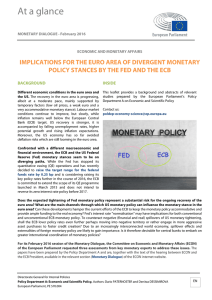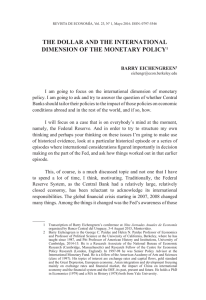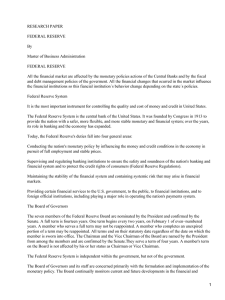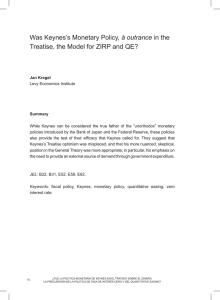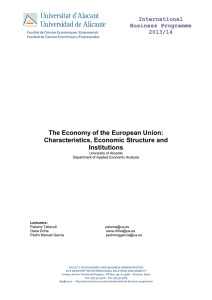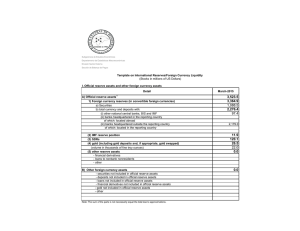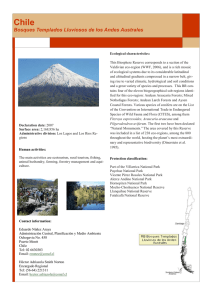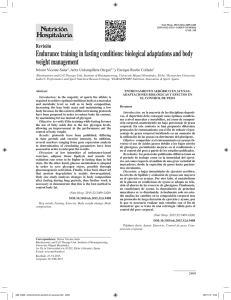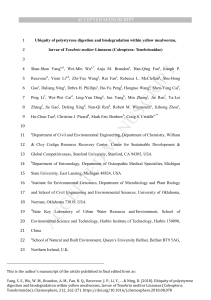Ensuring Sound Monetary Policy in the Aftermath of Crisis
Anuncio
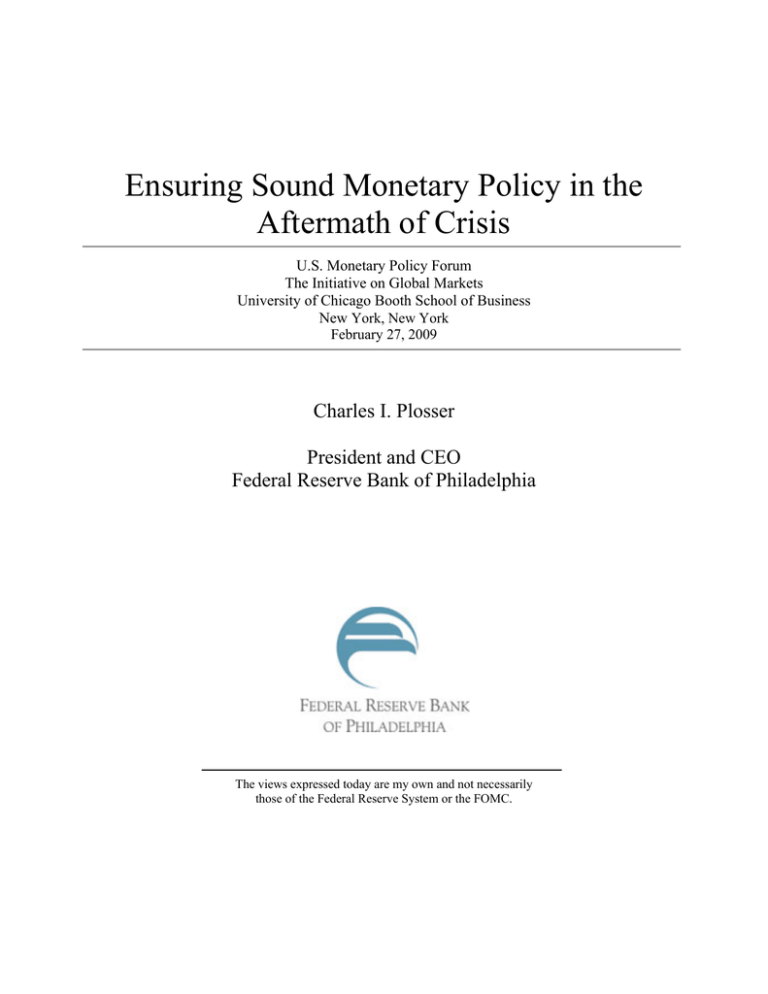
Ensuring Sound Monetary Policy in the Aftermath of Crisis U.S. Monetary Policy Forum The Initiative on Global Markets University of Chicago Booth School of Business New York, New York February 27, 2009 Charles I. Plosser President and CEO Federal Reserve Bank of Philadelphia The views expressed today are my own and not necessarily those of the Federal Reserve System or the FOMC. Ensuring Sound Monetary Policy in the Aftermath of Crisis Charles I. Plosser President and CEO Federal Reserve Bank of Philadelphia U.S. Monetary Policy Forum The Initiative on Global Markets University of Chicago Booth School of Business New York, New York February 27, 2009 The financial crisis and its ramifications for the broader economy have forced policymakers to be aggressive and creative in their efforts to deal with unfolding events. In my remarks today, rather than review how policymakers got here, I’d like to discuss some of the issues raised by our choices and suggest three ways to strengthen the Federal Reserve’s credibility and commitment to sound monetary policymaking going forward. 1 With December’s cut in the fed funds rate target to a range of 0 to 25 basis points, the Federal Reserve’s monetary policy entered a new regime. The FOMC’s statement indicated that the focus of policy will be to sustain the size of the Fed’s balance sheet at a high level. When the crisis began, the Fed responded by aggressively cutting the fed funds rate and by implementing a number of lending facilities intended to provide liquidity to disrupted credit markets. At first, the Fed was able to offset or sterilize its lending through open market operations, thus there was no significant increase in the size of the Fed’s balance sheet or in the amount of total central bank credit provided to the economy. As the turmoil in credit markets continued, we expanded the types of institutions that could access Fed lending and the types of assets we took onto our balance sheet. But the size of that lending soon made sterilization no longer feasible. Since September 2008, the Fed has increased total market liquidity while altering the allocation of credit to particular markets. As a result, the Fed’s balance sheet has more than doubled from just over $900 billion last September to almost $2 trillion in January 2009. Moreover, we can expect further increases as we continue to purchase mortgage-backed securities and agency debt and as we implement the TALF, or Term Asset-Backed Securities Loan Facility. This policy of quantitative easing has come into play because the nominal policy rate has effectively reached zero and further accommodation seems desirable. By expanding the quantity of bank reserves beyond that needed to keep the funds rate at zero, this policy is meant to support the economy. The policy also serves to prevent fears of deflation from turning into expectations of persistent deflation that would cause the real federal funds rate to rise. However, instead of 1 See Charles Plosser, “Credibility and Commitment,” speech given to the New York Association for Business Economics, New York, NY, March 6, 2007. 1 implementing the balance-sheet expansion by purchasing government securities, the asset typically found on the central bank’s balance sheet, the Federal Reserve has taken on a wide array of nontraditional assets — dramatically altering the composition of its balance sheet. Chairman Bernanke has called this “credit easing” to distinguish it from other forms of “quantitative easing.” 2 The rationale for credit easing in particular markets, rather than more traditional quantitative easing achieved by the acquisition of more market-neutral Treasuries, is that intermediation in a number of credit markets has been disrupted, and the Fed has decided to take an active role in efforts to improve that intermediation. The jury is still out, however, as to how effective these policies will be. But there is no doubt that the current framework for monetary policy and its reliance on targeted credit programs have carried the Federal Reserve into uncharted territory and poses some challenges for policy going forward. Today I would like to suggest three steps we can take now to strengthen the Fed’s credibility and commitment to fulfill its dual mandate of price stability and sustainable economic growth. I believe these steps can better position us when the time comes to resume more traditional monetary policy. The first step is to reinforce our commitment to providing a nominal anchor for our economy. It is essential to do so if we are to achieve the most unique of all our objectives — price stability. With the fed funds rate essentially at zero, and our focus on credit easing, we are allowing our balance sheet to grow, or shrink, based on criteria entirely unrelated to providing that nominal anchor. It is difficult to make credible commitments to price stability when the implementation of policy is disconnected from such an important policy objective. Fortunately, I believe there is a way out of this dilemma: the Fed should adopt an explicit inflation objective and publicly commit to achieving that objective over some intermediate horizon. To me, the exact number or price index for the objective is somewhat less important than the public commitment to a goal. Such a commitment would help anchor expectations more firmly and diminish concerns of persistent inflation or persistent deflation — not an inconsequential issue in the current environment. In addition to announcing an inflation objective, we must also clearly communicate our policy strategy to the public so that they understand how the FOMC anticipates achieving that goal. There are different ways to accomplish this. For example, Taylor-like rules that involve adjusting the federal funds rate in response to deviations of inflation from target and shocks to output or economic growth have some advantages. Such simple rules can be useful guides for conducting 2 A recent example of “quantitative easing” occurred in Japan between March 2001 and March 2006. Even before that, the Bank of Japan had entered a period of low interest rates, lowering its policy rate to zero in February 1999. Between February 1999 and March 2001, total assets on the Bank of Japan’s balance sheet grew by almost 40 percent, from 80 trillion yen to 110 trillion yen. In the five-year quantitative easing period, total assets expanded by another 40 percent, to a peak of 155 trillion yen in December 2005. Thus, it took over five years for the Bank of Japan to double its balance sheet. In contrast, the Fed doubled its balance sheet in about four months. Like the Fed, the Bank of Japan also bought more than just government securities. It purchased both asset-backed securities and equities from commercial banks. 2 systematic policy and can help effectively communicate to the public the conditional nature of policy choices. 3 Another advantage of such transparent and simple rules is that if the FOMC chooses to deviate from what reasonable guidelines would suggest, then the Committee would, and should, feel compelled to explain its reasoning, which would further improve the transparency of policy. Another form of communication that could be useful is for the FOMC to publish quarterly projections of the range and central tendencies of the Committee members’ assumed path of policy over the forecast horizon that they believe is consistent with achieving our dual mandate of price stability and sustainable growth. Some see a risk that the public may perceive these projections as a commitment to a particular path for policy. But the experiences of the central banks of Sweden, Norway, and New Zealand, which publish policy path projections, suggest that this risk can be overcome through careful communication. The second step toward strengthening the credibility of our commitment to sound monetary policy is to clarify the criteria under which we choose to step in as a lender of last resort. We must spell out when we will intervene in markets or extend unusual credit to firms — and then we must be willing to stick to those criteria. Moreover, we also need to complement such clear commitment with a well-articulated exit strategy from such liquidity or credit programs. Our lending programs were created for extraordinary times and involve significant intervention in the private markets, but they run contrary to a long-standing and sound Fed practice of trying to minimize the effect of its actions on the allocation of credit across market segments. In my view, such programs are not, and should not, be part of the normal operation of a central bank. The lack of clear ground rules for such intervention can lead market participants to speculate on the next facility the central bank will create or on the next asset class or firm it will rescue. Such speculation increases volatility and places other markets under stress. This is counter-productive to the programs’ stated objective of financial stability. Moreover, each intervention creates moral hazard that may lead market participants to take on more risk than they otherwise would — thus sowing the seeds for the next crisis. The lack of a clearly communicated exit strategy also creates uncertainty in the very markets we are serving with these facilities and also may prove counter-productive to achieving the stability objectives. For example, the central bank’s willingness to participate and to lend “cheaply” in selected markets may deter private-sector participants from returning to and restoring normal market functioning. Thus, an exit strategy might involve gradually raising the costs of using the facilities, which may encourage the markets to heal themselves. A clear exit strategy would also enhance the Fed’s credibility if the public understood that it does, in fact, have a plan to exit from these unusual interventions. My third and final suggestion is to draw a clearer distinction between monetary policy and fiscal policy and to ensure that the Federal Reserve retains its independence to conduct sound monetary policy. 3 See Charles Plosser, “The Benefits of Systematic Monetary Policy,” speech given to the National Association for Business Economics, Washington Economic Policy Conference, Washington, D.C., March 3, 2008. 3 This suggestion is motivated by the fact that the current crisis and the Fed’s interventions have dramatically altered the composition of the assets on our balance sheet and created confusion in the minds of many as to the respective roles of the central bank and the fiscal authority. These interventions and ensuing confusion have ramifications for our independence and for the conduct of monetary policy. Eventually economic conditions will improve, demand for excess reserves will fall, and in order to maintain price stability, the Fed will have to begin withdrawing the extraordinarily large supply of liquidity with which it has flooded the market. Under normal operating procedures, this isn’t a problem, as the Fed holdings are mainly short-term Treasuries, which can be liquidated to reduce reserves and increase interest rates. However, under current circumstances, the Fed has substituted less liquid assets for Treasuries. It is true that a number of the Fed’s new programs will unwind naturally and fairly quickly as they are terminated because they involve primarily short-term assets. Yet we must anticipate that special interests and political pressures may make it harder to terminate these programs in a timely manner, thus making it difficult to shrink our balance sheet when the time comes. Moreover, some of these programs involve longer-term assets — like the agency MBS. Such assets may prove difficult to sell for an extended period of time if markets are viewed as “fragile” or specific interest groups are strongly opposed, which could prove very damaging to our longer-term objective of price stability. Thus, we must ensure that our current credit policies do not constrain our ability to conduct appropriate monetary policy in the future. Even more important, credit allocation decisions, in my view, should be under the purview of the fiscal authority, not the monetary authority, since they involve using the public’s money to affect the allocation of resources. The mixing of monetary policy and fiscal policy increases the number of entities that might try to influence Fed decision-making in their favor. Both economic theory and practice indicate that central banks should operate independently from such pressures and resist them when they arise so that their policies benefit society at large over the longer term and not any particular constituency in the near term. So where should we go from here? One suggestion that would promote a clearer distinction between monetary policy and fiscal policy and help to safeguard the Fed’s independence would be for the Fed and Treasury to reach an agreement whereby the Treasury takes the non-Treasury assets and non-discount window loans from the Fed’s balance sheet in exchange for Treasury securities. Such an accord would offer a number of benefits. 4 First, it would transfer funding for the credit programs to the Treasury — which would issue Treasury securities to fund the programs — thus ensuring that credit policies that place taxpayer funds at risk are under the oversight of the fiscal authority. Second, it would return control of the Fed’s balance sheet to the Fed, so that we can continue to conduct independent monetary policy. Going forward, an agreement with Treasury would also state that if the fiscal authority at some point wanted the 4 For a discussion of such an accord in a different context, see J. Alfred Broaddus, Jr. and Marvin Goodfriend’s article, “What Assets Should the Federal Reserve Buy?” and Goodfriend’s article, “Why We Need an ‘Accord’ for Federal Reserve Credit Policy: A Note,” Federal Reserve Bank of Richmond Economic Quarterly (Winter 2001). Such an accord would also be consistent with the recommendations made by the Group of Thirty’s Working Group on Financial Reform about the role of central banks in providing financial stability. See “Financial Reform: A Framework for Financial Stability,” Group of Thirty, Washington, D.C. (2009). 4 central bank to engage in lending outside its normal operations and, importantly, should the Fed determine “unusual and exigent circumstances” warranted such action, then any accumulation of nontraditional assets by the Fed would be exchanged for government securities. This would preserve the Fed’s independence to control its balance sheet and ensure that the full authority and responsibility for fiscal matters remained with the Treasury and Congress, where it rightfully belongs. There is a historical precedent for such an accord. In 1951, the Treasury and the Fed struck an accord that freed the Fed from pegging the interest rate on long-term Treasury debt below 2.5 percent, which the Fed had done during and after World War II. 5 By pegging long rates below 2.5 percent, the Fed was committing to add reserves to the banking system when market interest rates began to rise without regard to its inflation goal. This inability to control its own balance sheet was a fundamental problem for the credibility of the Fed in achieving its dual mandate. After considerable negotiations, the Treasury and the Fed reached an accord that freed the Fed to set interest rates consistent with its long-term goals. This allowed the Fed to re-establish its independence and to conduct monetary policy in accordance with its dual mandate. Today, an accord to substitute Treasuries for non-Treasury debt on our balance sheet would similarly help ensure that the Fed will be able to implement its policy decisions. After all, the time will come when the Fed will want to begin raising interest rates to achieve its goals. With Treasuries back on the balance sheet, the Fed will be able to drain reserves in a timely fashion with minimal concerns about disrupting particular credit allocations or the pressures from special interests. It is always tempting to make policy based on short-term concerns and argue that we will worry about other things later. Yet, actions we take today have consequences for the choices we face in the future. We must recognize those consequences and take steps that ensure the effectiveness of future policy. Economics has shown that credible and committed policymaking yields better outcomes for the economy at large. By appropriately anticipating the longer-term consequences of our actions today, we can take steps that can ensure the Federal Reserve maintains and enhances its credibility as well as the ability to achieve its longer term objectives. Since we celebrated Abraham Lincoln’s birthday this month, I would like to close with a quote from our 16th president that seems particularly apropos to my discussion today: “You cannot escape the responsibility of tomorrow by evading it today.” 5 For several articles about the 1951 Accord, see the Federal Reserve Bank of Richmond’s Economic Quarterly (Winter 2001). 5
